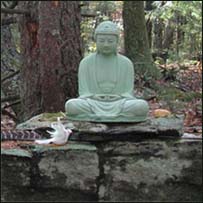|
|
 |
Please support Dharma Seed with a 2025 year-end gift.
Your donations allow us to offer these teachings online to all.

|

|

|
The greatest gift is the
gift of the teachings
|
|

|
| |
|
Dharma Talks
|
2012-07-14
Equanimity in Our Daily Life: Awakening to Our True Nature #1
54:39
|
|
Bhante Buddharakkhita
|
|
|
What does it means to be awake from moment to moment? Do you have difficulties in finding balance in your life? Are you centered and grounded in your daily life? We will explore the last two of the seven factors of awakening: Concentration and Equanimity. When mindfulness and concentration practice gains momentum, we will begin to find balance in our daily life. Equanimity will organically arise and serve as a supporting factor on the path to inner-peace, true happiness and final awakening.
The day will include mindfulness of walking, sitting, standing, discussion group, guided meditation instructions, question and answer session, and Dhamma talks.
|
|
New York Insight Meditation Center
:
NYI Regular Talks
|
|
|
2012-07-10
It's Really Possible!
60:32
|
|
James Baraz
|
|
|
To love ourselves, love others unconditionally to let in the love that comes our way, to realize more and more that love is our true nature -- these are tehe gifts of metta practice. With sincere intention and commitment, we can realize these fruits. We have everything we need to do this.
|
|
Spirit Rock Meditation Center
:
Metta Retreat
|
|
|
2012-07-10
Fundamentals of the Dharma: Mindfulness
62:01
|
|
Rodney Smith
|
|
|
Mindfulness is the ability to generate attention toward oneself or an outside object. It is a step toward more conscious living. But mindfulness is coming from our exertion of will; that is, we are making ourselves mindful. When we relax our efforts, mindfulness goes away. As long as we are in control we will continue to believe in the truth of separation and will not see the end of the assumption of self. This is the spiritual fix we are in: either we let go of mindfulness into effortless awareness, or we stay bound to the person who is making herself conscious and thereby limit freedom.
|
|
Seattle Insight Meditation Society
|
|
In
collection:
Fundamentals of the Dharma
|
|
|
|
|